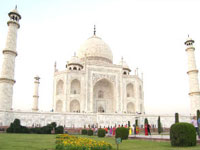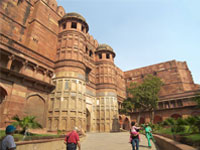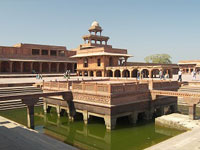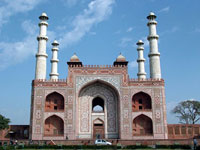| |
|
| |
Wild Desert Resort |
|
|
|
|
|
|
| |
 |
|
| |
| |
An Adventure on sand dunes and same. get a feel of shifting sand dunes Capturing the spirit of Sand Dunes and ensuring the perfect Dunes experience at Wild desert resort, a unique Sam Dunes Resort and Camp. |
|
|

|
|
|
|
|
|
|
| Agra |
Taj Mahal
 The Taj Mahal is one of the most famous tourist attractions in India and across the world. It's one of the Seven Wonders of the World. Completed in 1653, The Taj Mahal was built by Mughal Emperor Shah Jahan in memory of his beloved wife Mumtaz Mahal, as a symbol of eternal love. Taj Mahal is built on a red sandstone base, topped by a huge white marble terrace on which rests the dome flanked by four tapering minarets. The floors and walls have intriguing calligraphy and mosaic work adorned with precious stones.
The Taj Mahal is one of the most famous tourist attractions in India and across the world. It's one of the Seven Wonders of the World. Completed in 1653, The Taj Mahal was built by Mughal Emperor Shah Jahan in memory of his beloved wife Mumtaz Mahal, as a symbol of eternal love. Taj Mahal is built on a red sandstone base, topped by a huge white marble terrace on which rests the dome flanked by four tapering minarets. The floors and walls have intriguing calligraphy and mosaic work adorned with precious stones.
 Agra Fort Agra Fort
Agra fort was commissioned by the great Mughal Emperor Akbar in 1565. During Shah Jahan's era, the red sandstone fort was reformed into a palace and extensively repaired with marble and pietra dura inlay.
Distinguished buildings in the fort are the Pearl Mosque, Jahangir's Palace, Diwan-e-Am, Diwan-e-Khas (public and private audience halls), Shish Mahal, Musammam Burj and the
Khas Mahal. The fort is semi-circular shaped, flattened on the east with a long, nearly straight wall facing the river.
 Itmad-ud-Daulah's Tomb Itmad-ud-Daulah's Tomb
This Mughal Mausoleum in the city of Agra was built at the command of Noor Jahan (wife of Jahangir) for her father Mirza Ghiyas Bagh, who was honored with the title of Itmad-ud-Daula (pillar of the state). This is where the mausoleum took its name from.
The walls of the mausoleum are built in white marble and embedded with semi precious stones. The cenotaphs of both the father and mother of Noor Jahan lay side by side in the tomb.
 Fatehpur Sikri
Founded by the great Mughal emperor Akbar, in the year 1569, Fatehpur Sikri served as the capital of the Mughal Empire during the years 1571-1585. Named as Fateh (meaning victory) in the beginning, it was later known as Fatehpur Sikri. It was home for the birth of navaratnas (9 jewels). It stands as a representation of the infamous Mughal architecture with unique designs and artworks. The building was made of red stones and Akbar intended to revive the Persian court splendors made by his ancestor Timur, but eventually it came through as the classic Indian embellishments. The Fatehpur Sikkim was deserted after its completion due to natural calamities of insufficient water further triggered by the proximity of the Rajputana areas. The city is a piece of art that surrounds brilliant works by great minds of the strong Mughal period influenced by the emperors. Fatehpur Sikri
Founded by the great Mughal emperor Akbar, in the year 1569, Fatehpur Sikri served as the capital of the Mughal Empire during the years 1571-1585. Named as Fateh (meaning victory) in the beginning, it was later known as Fatehpur Sikri. It was home for the birth of navaratnas (9 jewels). It stands as a representation of the infamous Mughal architecture with unique designs and artworks. The building was made of red stones and Akbar intended to revive the Persian court splendors made by his ancestor Timur, but eventually it came through as the classic Indian embellishments. The Fatehpur Sikkim was deserted after its completion due to natural calamities of insufficient water further triggered by the proximity of the Rajputana areas. The city is a piece of art that surrounds brilliant works by great minds of the strong Mughal period influenced by the emperors.
 Akbar's Tomb Akbar's Tomb
Built solely for the great Mughal emperor, the Akbar Tomb was built in 1605-1613. It covers a good area of 119 acres in the Sikandra. It was Akbar himself who initiated the works in 1600 as per the Tartary tradition. Located in the suburbs, about a kilometer away lies the tomb of Miriam, Akbar's wife. The southern gate is similar to those of the Taj Mahal with 4 white marble chhatri and also serves as the entrance to the tomb. A wall of 105m square surrounds the tomb. The fake tomb is located in the marble pavilion placed inside a 4 tier pyramid building while the true tomb is safely kept in the basement. The building is made up of red sandstones with touches of white marble. One of India's greatest assets, the tomb is an attractive tourist spot, with people eager to see the tomb flooding the place.
 Jama Masjid Jama Masjid
Built in the 1648s, by Shah Jahan, Jama Masjid stands facing the Agra fort and overlooks the Agra Fort Railway Station in India. It was built by Shah Jahan in dedication to his favorite daughter. In order to create the Agra Fort Railway Station, the octagonal Tripolia Chowk was destroyed. The main entrance is on the eastern side. The prayer chamber is decorated with slender turrets with alternate kiosks. It is said to be the largest dome among the three and also the highest, crowning the sanctuary. The archway of the central portal has Persian inscriptions on white marble inland with black stones, in praise of Shah Jahan and Jahanara, his daughter. Made of red sandstone and marble, took 5,000 workers a period of 6 years to complete the magnificent building. It stands on a high plinth and has 5 arched entrances leading to the courtyard.
FESTIVALS
KAILASH FARE :
Held at Kailash about 12 k.m. from Agra in the month of August/September. It is a major fair celeberated in honour of Lord Shiva who is belived to have appeared here in the form of stone Lingam.
SHEETLA FAIR :
It is held near Delhi Gate in July/August month.
BATESHWAR FAIR :
A month long festival is held annualy during the month of November at the place called Bateshwar, Which is about 65 k.m. from Agra.
URS (FATEHPUR SIKRI) :
This fair is organised at Sheikh Salim Chistti's Dargah during the month of Ramzan.
Air
Closest International Airport is the 'Indira Gandhi International Air Terminus' located in New Delhi. Agra is also well-connected through domestic flights to cities like Delhi, Khajuraho, Varanasi etc. For bookings contact Tour operators.
Rail
Agra is connected to all the major cities of India by Railways. For bookings contact
Tour operators.
Road
Agra is well-connected to the following cities by road : Mathura, Delhi, Chandigarh, Kanpur, Lucknow, Varanasi, Jhansi, Chitrakoot, Gwalior, Udaypur, Khajuraho, Jaipur, Calcutta, Mussoorie, Mumbai etc.
Agra's distance by road from the following cities is :
- Delhi : 203 km
- Khajuraho : 393 km
- Gwalior : 118 km
- Jaipur : 237 km
- Calcutta : 1287 km
- Varanasi : 657 km
- Mussoorie : 417 km
- Mumbai : 1204 km
Air Conditioned/non air-conditioned taxies and luxury coaches are available through Tour operators for travelling to and from Agra to other cities.
|
|
|


